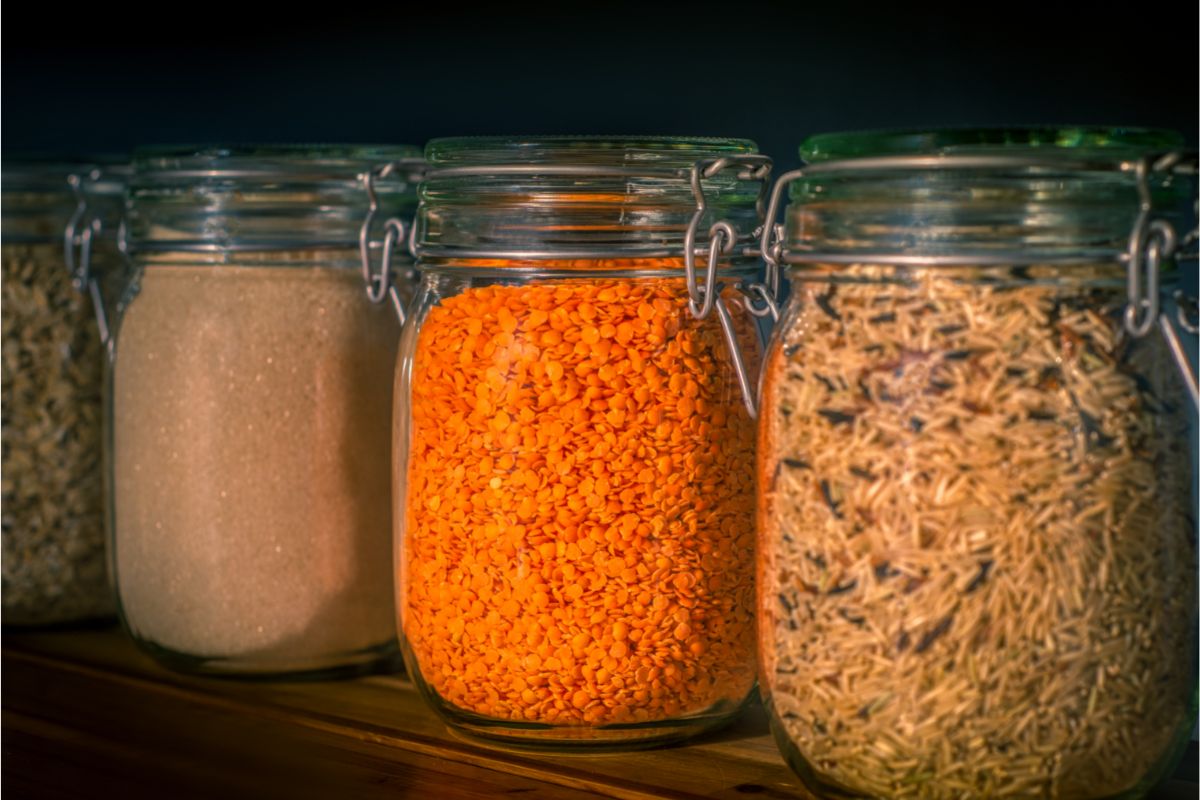To package and store dry goods safely, use airtight containers. Keep them in a cool, dry area away from sunlight and moisture. For bulk storage of dry goods, rotate the stock regularly to keep it fresh.
Table of Contents
The 5 Guidelines of Dry Storage
Following these recommended guidelines for storing dry food items will keep them fresh and prolong their shelf life.
1. Use airtight containers.
Dry goods like flour, sugar, and grains should be stored in airtight containers to prevent oxygen, moisture, and pests from getting in. The containers should have tight-fitting lids and be free from nicks and imperfections.
2. Clean your containers.
Clean your dry goods containers regularly to prevent the buildup of bacteria and other harmful microorganisms. Wash them with warm, soapy water, rinse thoroughly, and allow them to dry completely before refilling them with fresh ingredients.
3. Keep them cool and dry.
Keep your dry food items away from direct sunlight, heat sources, and moisture. A pantry, cabinet, or cupboard that’s well-ventilated and away from the stove is a good location.
4. Rotate your stock.
Practice the FIFO (first in, first out) rule, where you use the oldest food items first to keep your stock fresh and avoid food waste.
5. Label all dried goods.
Keep your dry food products organized to ensure you don’t mix up similar-looking items. Label them using stickers or masking tape, or write directly on the container with a marker to label the contents and the date.

What are the Benefits of Storing Dry Goods?
There are many long-term benefits of storing dry goods:
- Bulk purchases of dry goods reduce packaging waste
- Buying dry goods in bulk is cost-effective
- Dry goods such as beans, lentils, and white rice are nutritious
- Reduces trips to the grocery store, saving time and effort
- Storing dry goods properly extends shelf life
Should You Store Dried Goods with Oxygen Absorbers?
Dry goods should be stored with oxygen absorbers. They serve to protect dry foods by removing the oxygen present in the sealed containers, creating a high-nitrogen environment to keep the food safe. The oxygen scavengers are not edible but are safe to use in dry goods storage to extend their shelf life.
Foods that are kept for 3 months or more should have an oxygen absorber placed inside to make them shelf stable.
What are the Best Food Storage Containers to Use to Store Dry Goods?
Always use sturdy, airtight containers, such as Mason jars, to store your dried goods.
Food Storage Containers to Use
Glass Jars: Glass containers, such as canning jars, are non-toxic, non-porous, and easy to clean.
Mylar bags: These bags feature a thick foil laminate layer that prevents moisture, light, and odor from reaching your dry goods.
Plastic Containers: Plastic containers made from food-grade plastic are lightweight, durable, and come in a variety of sizes and shapes. They should have a tight-fitting lid to keep the moisture out.
Tins: Storage containers made from tin metal are sturdy, easy to clean, and help prevent light and moisture infiltration.
Food Storage Containers to Avoid
Cardboard boxes: Similar to paper bags, cardboard boxes are porous and can absorb moisture, leading to mold and other issues.
Containers that held non-food items: Avoid using containers that held cleaning products or chemicals, as they may contain harmful residues that can contaminate the food.
Original packaging: While dry goods can be stored short-term in their undamaged, original packaging, they are more vulnerable to pests and moisture.
Paper bags: These bags are porous and can allow moisture and pests in. They tear easily, leading to spills and waste.
Plastic bags: Some plastic bags may contain harmful chemicals that can leach into the food over time.

How Do You Store Large Quantities of Dry Goods?
Storing dry goods in large quantities requires durable bulk bags. These bags can hold fifty pounds of dry food, such as whole wheat, white rice, beans, pellets, dog food, and more. Store bulk bags in a cool and dry storage area with proper air conditioning.
Watch out for rodents and keep pests away from the storage area by using pest repellents or rodent traps and bait. Keep the bulk food sacks about 6 inches off the ground to make pest infestation difficult.
If you are using buckets for bulk dry food storage, make sure they have airtight lids and are made of food-grade plastic.
What is the Best Way to Avoid Pests in Dry Food Storage?
Pest infestations in your dry food make it unsafe for consumption. Protect your food by following these guidelines:
- Always store dry food in airtight containers.
- Clean the surfaces around the storage area with a disinfectant, and keep them dry at all times.
- Refrigerate your dry food. Eggs and larvae from pests cannot survive in frigid environments.
- Rotate your stock regularly to avoid attracting pests.
- Use pest repellents to deter pests from your dry food storage area. You can use cinnamon sticks, bay leaves, and cloves to chase away weevils and moths from your pantry.
What Does it Mean to Store Dry Foods in a Cool, Dry Place?
The temperature of food storage areas should be between 50°F and 70°F, with a humidity level below 60%.
Moisture in the air causes dry goods to spoil or become moldy. A cool and dry storage area such as a cupboard or pantry extends the shelf life of dry goods.
How Do You Know if Dried Food is Spoiled?
Discard any dried food that shows these signs of spoilage:
- Bad odor. If the dried food has a strange, off-putting odor, trust your sense of smell and discard it immediately.
- Change of color or texture. Discard any food that is moist, sticky, or slimy.
- Expired food. Even if the food looks and smells fine, if it is expired, it could be unsafe to consume.
- Signs of mold or insect infestations. Consuming mold or insects can be harmful to your health.

